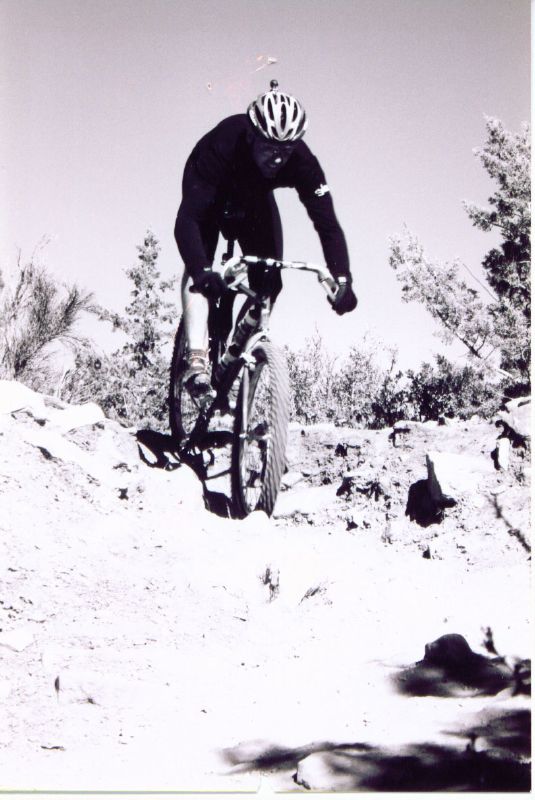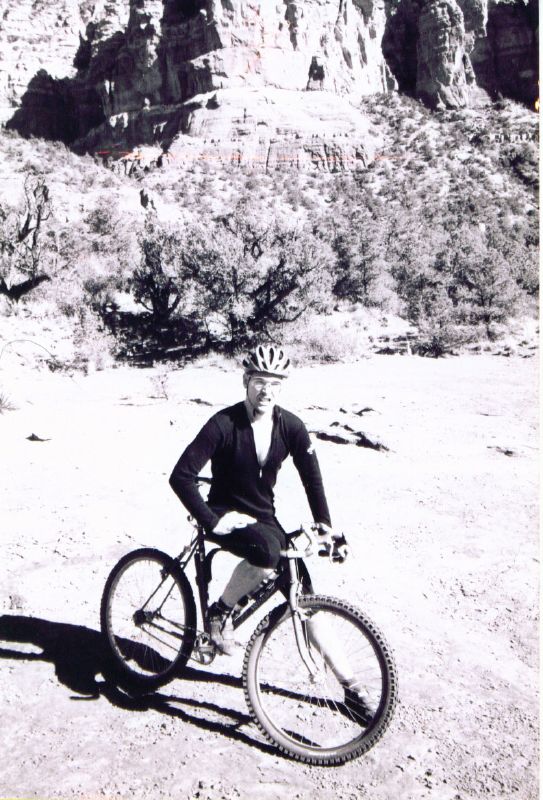 |
| 3.3:1 gain ratio, 44.9 gear inches |
For the record: I bought it back in 1995 from it's second owner, and have always run it as a singlespeed.

UPDATES:
Because of its vintage it's got a few neat old-school features, like a braze-on behind the seat-collar for a Hite-Rite, and a couple braze-ins on the main triangle for a portage-strap. To accommodate the shoulder of the portager, the bottle cage mounts are both located on the down-tube. Otherwise, in terms of design details and geometry, the bike is decades ahead of its time.
It's a blast to ride, though a bit of an ass-kicker, too, to be honest. Nevertheless, to this day, I ride it a lot. It's about as simple and elemental as riding a mountain bike in the woods can possibly be. I think this is why I ride it as often as I do. Such experiences have always crumbled my cookie.
My buddy, Mark, who I bought the bike from in '95 got it about a year before that from guy named Michael, who was the original owner. Turns out Michael was a friend and neighbor of Paul's back when they both lived in Santa Cruz in the '80s. Michael, who's now an NAU Geology prof and a semi-regular customer at the bike shop where I work in the summertime, once told me that Keith Bontrager himself cut-down, re-rolled, and laced the front wheel. But other than Michael's compelling provenance, and the small "The Bicycle Trip" sticker on the rim, I have no real, substantial proof of that interesting little bit of history, which really is too bad.

When I first got this bike it was blue and the frame decals were peeling a bit at the corners. It's still blue. And the frame decals are still peeling. But please don't assume I've let the bike languish. I haven't. For one thing, I took off the incredibly-huge original quill stem and substituted a new, custom-made, significantly shorter, and slightly taller Rock Lobster quill stem, chiefly so I could get a set of WTB/Nitto Dirt Drops into more-or-less the right place. When I contacted Paul to order the stem (by telephone, ya see, 'cause this was in, like, the 1990s, back before teh internets tubes were invented) he was super nice about making sure I got the right stem for this bike ("It's gotta be fillet. Can't put a TIG'd stem on that bike."). He even sent me a nice handwritten note along with the stem, all about when he built the bike and what kinds of tubes he used to make the frame... and also a few suggestions as to how I might choose to light it for formal museum-quality display.
I built a new rear wheel for it a couple years ago. All by myself. No, seriously. I did. I even put fancy anodized gold and blue spoke nipples on it... and I got the every-other nipple-color thing right... and I got the hub-logo direction thing right... and I got a whole bunch of other things right, too.
The wheel I built is a Surly fixed-free flip-flop hub on a Mavic something-or-other hoop. I've got it set-up with an easy-climbing 34x20 gear on both sides, which is a great singlespeed gear around these parts, but a fairly low fixed-gear gear for anywhere that isn't dead flat. But still, sometimes I ride it fixed in the woods anyway. Mostly, though, fixed off-road in Flagstaff is just stupid-hard and no fun, no matter what gear you're running. So, really, I usually ride it as a singlespeed, and coast a lot and do bunnyhops and smile and have fun and stuff on downhills... and just talk-tough about how awesome riding fixed-gears on singletrack is.
But, really, it's not.
Here are some other pictures of me having fun riding this bike:
- In May 2010 I noticed a crack in the Rock Lobster's seat-tube.
- In July 2010 I sent the frame back to Paul to be repaired.
- He returned it to me, fixed, in early September 2010. He refused to accept payment for the repair.
- I had it repainted in October 2010.
- Since that time, I have replaced the old Suntour cranks with a much prettier set of Cook Bros. and installed a Thompson post instead of the well-worn Kalloy. The portage-strap, which I made from a piece of an old back-pack (and for which, as noted above, there are braze-ins installed on the frame) comes and goes.
- In September 2016, I replaced the dropbars with a stylie set of 28" wide chrome-plated genuine Nitto Bullmoose bars and a pair of super-giant old-school Shimano M762 brake levers. Cool!
- In June 2019, I replaced the Bullmoose bars with a fairly generic 680mm matte black Answer Alumilite handlebar with a nice rise to it and some good sweep, too. Just for fun, at the same time, I also reinstalled the "the incredibly-huge [160mm!] original quill stem" which hasn't been on the bike since the day I bought it back in 1990-something. Likewise, the super-giant Shimano M762 brake-levers were traded during this update for a period-correct pair of gently-used SS-5s, black with the plasti-dipped handles, natch.
- In October 2020, I replaced the 160mm stem with a custom fillet 130mm Rock Lobster stem, put the Shimano M762 levers back on (again. They work much better with the BR-MT62 cantis) and reinstalled the Hite Rite. I also fashioned a new leather portage strap from an old belt and installed it using the original braze-ins on the top- and seat-tubes.






























